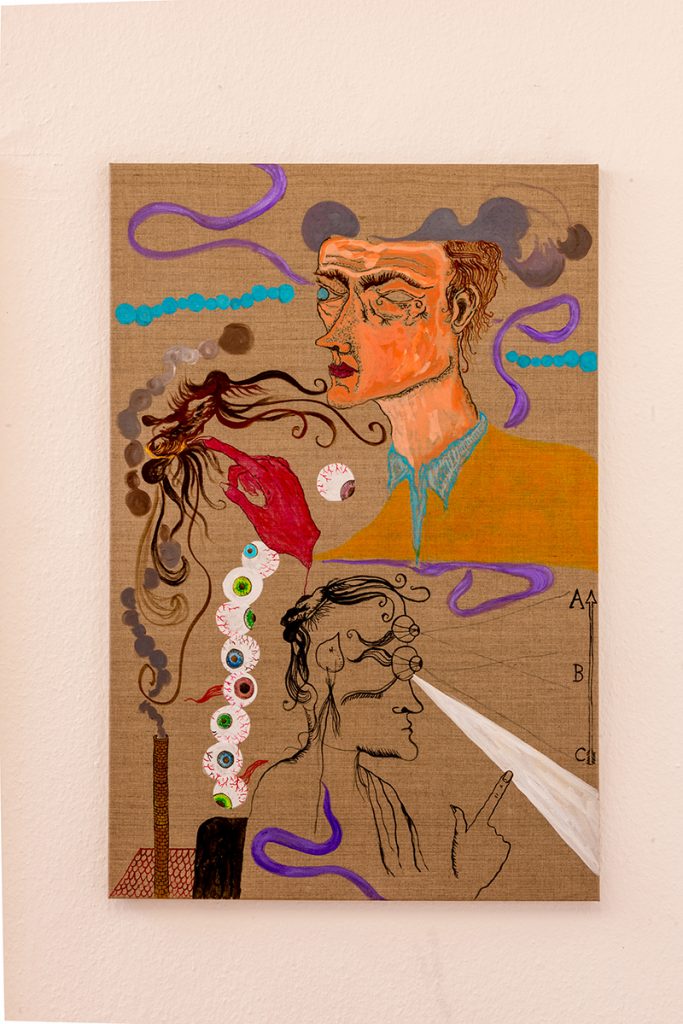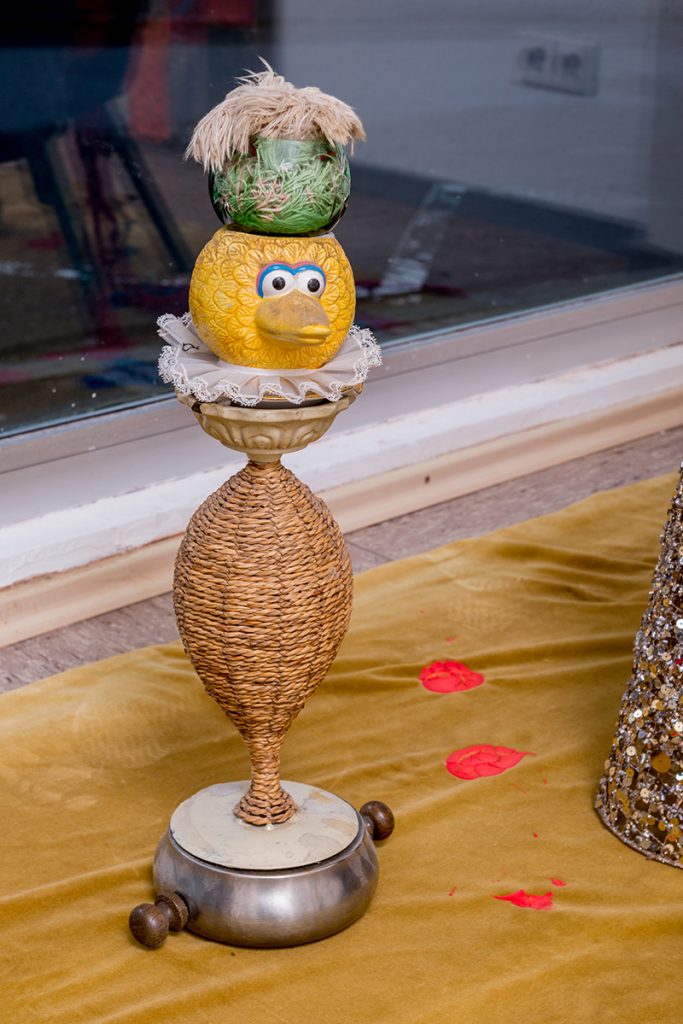Abel Auer
SÉANCE Die Beschwörung des Homunculus (Kunstmensch)
Exhibition: 29.05.2016 – 09.07.2016
Opening: 28.05.2016, 15:00
|
|
Press Release:
Der Homunkulus ist der Kunstmensch, das alter Ego, die Skulptur. Es gibt da eine bestimmte Tradition im Erschaffen von künstl(er)i(s)chen Doppelgängern, wobei hier nicht wie in der Romantik das Doppelgängermotiv einen Identitätsverlust symbolisiert, eine manipulierte Spiegelung vielleicht, aber in diese Richtung will ich nicht unbedingt weiterdenken, mit Spiegeln will ich nichts zu tun haben, da kann sich zu leicht ein Lacan dahinter verbergen. Igitt – oder Yikes, was ich trotz Anglizismus der Wortlustigkeit halber bevorzuge.
Den Kunsthomunkulus kann man bei Paul Thek in dem Werk „In The Tomb – Death of a Hippie“ finden, so auch bei Kippenberger in den „Ab in die Ecke Martin schäme dich“ Skulpturen, von Kai Althoff gibt es auch so Figuren die an ihn selbst erinnern, auch wenn er das wohl anders sieht. Ich habe auch schon mit einem solchen Homunkulus hantiert – in der Ausstellung „Wo warst du! All Ambra“ in Innsbruck 2006 gab es ein Alter Ego auf einer Krankenbahre, also nicht gleich tot wie bei Paul Thek sondern bloss krank, durchaus auf Genesung hoffend… Tod, Scham, Krankheit – irgendwie müssen diese Figuren wohl immer etwas ertragen, was man selbst nicht erleiden will. Das mit der Scham müsste man schon selbst aushalten, dafür gibt es keine Stellvertreter.
Der Künstler ist der Kunst-mensch also der Homunkulus. Eine Selbstskulptur ist schon was anderes als ein Selbstportrait im Bild, das hat eine ganz andere alchemistische Wertigkeit. Folgendes weiss man noch über den Homunkulus: „Der Begriff des Homunkulus hat zudem in der Philosophie und Neurowissenschaft weitere Bedeutungen erhalten. In der Philosophie der Wahrnehmung und der Philosophie des Geistes wird mit dem Begriff „Homunkulus“ auf die Idee Bezug genommen, dass es im Kopf nochmals ein Wesen gebe, das Reize wahrnehme und Erlebnisse habe. Zwar glaubt vermutlich kein Philosoph, dass es einen Homunkulus im Kopf gibt, allerdings werfen Philosophen gelegentlich bestimmte Theorien auf, welche die Existenz eines derartigen Wesens unausgesprochen enthalten. Wenn man etwa annimmt, dass in der visuellen Wahrnehmung ein Bild auf die Netzhaut projiziert wird, das als Bild dann in das Gehirn gesendet wird, dann müsste es im Kopf nochmals ein Wesen geben, das sich diese Bilder anschaut.“
Ich sehe den Homunkulus eher außen – er beobachtet mich, den Künstler, bei seiner Tätigkeit, dem Leben. Er ist der Mensch, ich bin nur der Künstler. Vielleicht kann ich der obigen Idee folgend das Künstlertum in ihn transferieren und dann meinen Frieden haben und in der Buchhandlung arbeiten. Da St. Georgen ja so etwas wie Kippenbergers Refugium war und sein Geist hier irgendwie präsent ist, so könnte der Homunkulus auch seiner Beschwörung dienen. Jemand wie er fehlt schon sehr, jemand mit Haltung, der das Prätentiöse und Klischeehafte in der gegenwärtigen Kunst (und es wird ja immer schlimmer) beim Namen nennt, überspitzt und wegwischt. Ein halbguter Kunstprofessor hat mal in Anlehnung an das bekannte Machwerk „Kunst kommt nicht von Können“ gesagt, Kunst kommt von nicht anders können, dass es also eine bestimmte Kondition in manchen Exemplaren unserer Gattung ist, nicht wählbar, ein Elend sozusagen. Wer nicht muss, der soll nicht sollen! Was wird es zu sehen geben? Eine Installation, eine Beschwörung, keine Ahnung ob es gelingt. Nix weiß ich doch.
(nicht ob es so richtig ist
such doch auch bloss das Arkanum….)
Pressetext:
The homunculus is the art-man; the alter ego. It is also the sculpture. There’s a certain tradition of the creation of an artistic-artificial Doppelganger, but in this case the motive behind it doesn’t symbolize a loss of one’s identity, rather perhaps a manipulated mirroring. However I don’t necessarily want to think further in that direction – it is too easily possible that a Lacan is lurking behind it. Yikes!
You can find the art-homunculus in Paul Thek’s work “In The Tomb – Death of a Hippie”, as well as in Kippenberger’s “Martin, Into the Corner, You Should Be Ashamed” sculptures, also there are such figures by Kai Althoff, that resemble himself, even though he would possibly see that differently. I have also handled such a homunculus before – in the exhibition “Wo warst du! All Ambra”, 2006 in Innsbruck which featured an alter ego on a stretcher, so it wasn’t directly dead like Paul Thek’s, but only ill and quite hopeful for a recovery… Death, shame, illness – somehow these figures always seem to have to put up with something that you yourself don’t want to suffer from. It should be possible to withstand shame though, there needn’t be any substitutes for that.
The artist is the art-man and therefore the homunculus. A self-sculpture is admittedly something different to a self- portrait in painting – it has a totally different alchemical significance. The following are some more known things about the homunculus: “The term homunculus has obtained further definitions of meanings in philosophy and neurosciences. In the philosophy of perception and the philosophy of the mind the term homunculus refers to the idea that there is another being in your head that can sense stimuli and has experiences. Though presumably no philosopher will believe that there is a homunculus inside one’s head, however some philosophers occasionally bring up certain theories that imply the existence of such a being unexpressedly. If one would assume that for visual perception an image is projected onto your retina which then is sent to the brain as an image, then there has to be another being inside your head that looks at these images.”
I see the homunculus as more outside – he is watching me, the artist, in my occupation, life. He is the man, I am only the artist. Maybe, following the above idea, I can transfer my artistdom onto him and then have my peace and work at a bookshop. As St. Georgen was supposedly something like a retreat for Kippenberger and as his spirit is somewhat still present here, the homunculus could also serve as his invocation. Someone like him is really dearly missed, someone with poise who calls out the pretentious and clichéd in contemporary art ( it’s getting worse and worse) and pushes it over and wipes it away. A half-ok art professor once said after the famous saying “art does not come from ability” that art comes from no ability to do otherwise, meaning that it is a certain condition in some specimen of our kind, not something to be chosen, quasi a misery. Who doesn’t have to, shouldn’t should!
What will be there to look at? An installation, a summoning, no idea if it will work. But nothing I know.
(not if it is correct like that
also just searching the arcanum….)

























